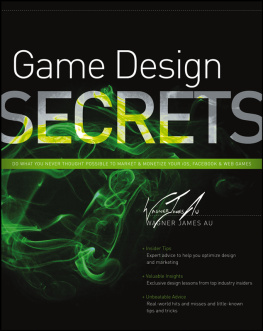Appendix . Epilogue Last Words
So this is where Rusel and I stopped working on the first edition of this book. Now that you understand the structure, you can see that this book can never really be complete until we document every part of every game ever made! So for this first edition, we picked lots of interesting topics and designed it entirely as an inspirational reference book for you.
Weve set up a website (www.gamedesignbook.org) so you can help us on the second edition, and hopefully together we can inspire new students and game designers all over the world.
We just hope that at some point, when going through the material, we helped trigger an idea thats completely original, thats yours, and that would be really cool in a professional video game.
As long as we achieved that, then mission accomplished, and now its up to you to go and make that game experience happen.
Im working on another site called www.gameinvestors.com to try to give great ideas a chance to get spotted by investors, publishers, and developers. So we might be able to help you again when you reach that milestone.
Chapter 1. Using This Book as a Reference
This book is the result of several years of research and mental exercise, as well as the product of years of game playing and designing. The goal was always to provide a tool to encourage designers and to assist anyone connected with a game project. My vision was that this book would accompany you to design meetings and brainstorming sessions, and that everyone on the team would have access to a fund of ideas and possibilities.
Of course, my initial goal was to think of absolutely everything possible, but, of course, I knew that would never happen. This book is a work in progress, and I fully intend on seeing it improve over time. I welcome suggestions and ideas, which you can offer by posting at davidperry.ning.com.
As the book evolved, it became clear that it could serve both as a reference and as a brainstorming tool. I envision people sitting with the book at hand, considering different approaches to their design and referring to different sections of the book for ideas and inspirations. Throughout the book, my coauthor and I have added suggestions about other sections to consider. By checking different lists and descriptions throughout the book, you may discover ideas or possibilities you hadnt previously considered, or you may simply find it easier to refer to the lists in this book to help you with different areas of design.
For instance, , Character Design, includes a step-by-step method for filling out the personality and background details of any character in your game, referring constantly to more fully fleshed-out sections of the chapter for further detail. If youre looking to consider items you might place along a road or highway, we have a list of possible items. Another list describes the different roles characters may play or the jobs they may perform, and one of our favorites is a categorized list of ways to die (or kill, for that matter).
You want weapons? We have tons of them, including historical, ethnic, and modern weapons, with a bit of history and technology thrown in for good measure.
Simply put, we encourage you to open the pages of this book in any way that serves your needs. You can read it as a textbook, use it as a reference, or simply refer to it for ideas from time to time. You can take the challenge to discover something weve missed and let us know what it is, or you can take it to meetings and use it to discuss different design decisions. Its completely up to you how you use this book, but we sincerely hope you find it useful.
Delving Deeper
None of the lists in this book is complete, and no discussion covers every angle. For instance, in the lists of weapons and armor that occur at the end of the book, there is no way we could include complete details for each item listed. Therefore, if you are interested, say, in modeling the early tanks of World War I, find some tanks and look them up in other references to find pictures and more specifics about armament, horsepower, and firepower. If you find yourself intrigued by our chapter on puzzles, use it to inspire further thinking and ponder the depths of puzzle design. Wherever you find a discussion or list in this book, use it to expand your design options, and always realize that the material in this book is only the suggestion of ideasthe rest is up to you.
In the next chapter, youll find some suggestions on how to brainstorm new ideas. You can brainstorm with a group of your fellow developers or in your own mind. We hope youll find this book helpful and inspiring, not only with its specific information, but with its suggestion of new ideas and its constant challenge to you to discard the ordinary and seek the remarkable, innovative, and unique solutions that will make your game not only massively fun to play, but a trendsetter, a pioneer, and a fresh experience for your players.
Chapter 2. Brainstorming and Research
This book is meant to be a page-turnerliterally. I want you to turn the pages often, using different sections of the book as you produce original ideas and concepts for your games. I see this as the equivalent of your own built-in brainstorming process. By using the many sections of this book, the lists, and the concepts, you can produce your own ideas, test and expand them, and challenge yourself to go beyond what Ive presented here.
I call this a brainstorming book because brainstorming is one of the most effective ways to discover new ideas. In a group of creative individuals, brainstorming can uncover options and directions that one individual would rarely discover. Using this book, you can expand your ideasand oursto create the most original concepts possible, while staying within the context of effective game design.
In this chapter:
Using Brainstorming in Groups
One of the best ways to get great ideas for your games is to hold brainstorming sessions with your whole staffdesigners, artists, programmers, producers, marketing and PR people, and so on. Not only does this produce some really great and original ideas, but it reinforces and builds teams and gets the whole group invested in the result. For those without a design background, this book can be especially helpful, because they can instantly look up different solutions to design challenges.
Hold on, whoa, did I really say PR and marketing people? In a game design brainstorming meeting? Absolutely, the more minds in the room (that are willing to speak up), the better. Even if they dont play games and they have bad ideas, sometimes really bad ideas spark thoughts that lead to really good ideas, so dont filter the room to just people who like what you likethats really going to tone down the potential breakthroughs.
Brainstorming is a very specific process. It essentially consists of freeform thinking out loud. Here are some suggestions for conducting effective brainstorming sessions:
Have a whiteboard, chalkboard, or flipchart to write ideas on. Expect a lot of ideas, so plan ahead. (Ideally, the person leading is focused on the group, not on drawing.)
Provide some pizza and beer. Seriouslydepending on the company and its personality, have some snacks and drinks. For marathon sessions at some companies, that might be pizza and beer, or for shorter sessions, possibly chips and sodas. Coffee and tea can be useful, too. Caffeine actually lowers inhibitions and makes people talk more freely. (Thats why cops are happy to offer you coffee or cola during interrogation.) The particular fare is entirely optional and based on the company culture. In more formal meeting structures, snacks may not be appropriate, but eating sometimes makes the session seem less formal and therefore encourages a freer expressive atmosphere.

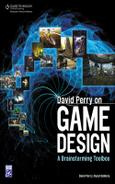
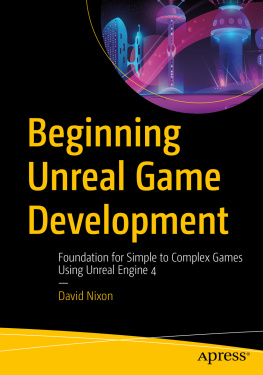


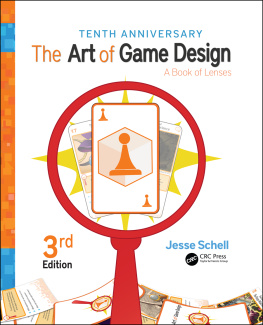
![Scott Rogers [Scott Rogers] - Level Up!: The Guide to Great Video Game Design](/uploads/posts/book/119441/thumbs/scott-rogers-scott-rogers-level-up-the-guide.jpg)
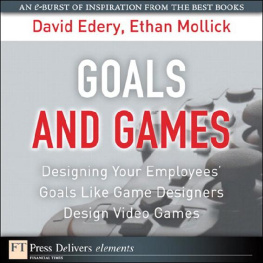
![Jesse Schell [Jesse Schell] - The Art of Game Design, 2nd Edition](/uploads/posts/book/119435/thumbs/jesse-schell-jesse-schell-the-art-of-game.jpg)
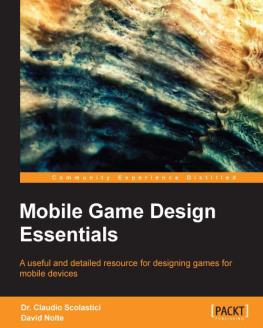
![Ethan Ham [Ethan Ham] - Tabletop Game Design for Video Game Designers](/uploads/posts/book/119417/thumbs/ethan-ham-ethan-ham-tabletop-game-design-for.jpg)
![Chris Bateman [Chris Bateman] - Beyond Game Design: Nine Steps Toward Creating Better Videogames](/uploads/posts/book/119409/thumbs/chris-bateman-chris-bateman-beyond-game-design.jpg)
